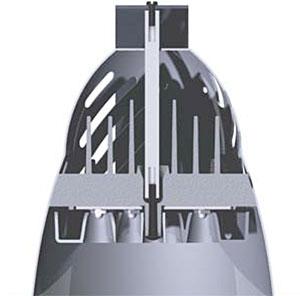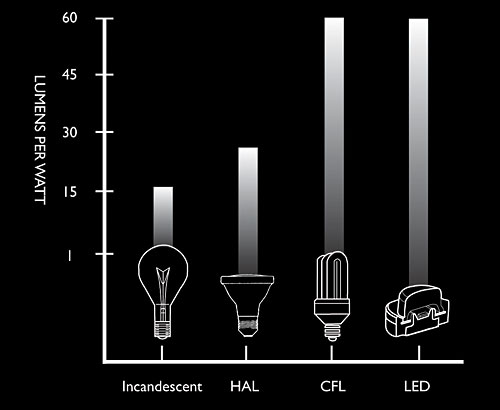The Fourth Source: Light-Emitting Diodes (LEDs) for General Illumination
The challenge-and opportunity-of LEDs
SSL, however, also presents significant challenges to both fixture manufacturers and lighting specifiers. For example, fabricators of LEDs have worked hard to produce consistent light sources with minimal variation in lumen output over the longest period of time possible. Also, LEDs are inherently monochromatic, which explains their success in red exit signs, green traffic lights and in decorative signage. But that also means that LEDs require special formulations and combinations to produce the white light used in most interior and exterior lighting. Today, however, there is broad agreement among lighting designers, fixture makers and LED fabricators that consistent, bright-white light is achievable with good long-term performance and at a reasonable cost.
With this new, highly efficient source suddenly a viable option for general illumination, over the last two years architects have seen new products for interior, exterior and other general applications hit the market. "We just got to point where models have the color, brightness, efficiency and power to deliver good general illumination," says MJ Paul, an executive with Kim Lighting. "LEDs have arrived, and you can now use them for general illumination, not just accent effects and decorative applications."
Not all products meet the basic engineering standards needed to make them work, however, caution lighting designers and engineers (see "LED Fixture Selection Criteria: General Illumination").
Â
|
Â
How LEDs work
Better known as an LED, the light-emitting diode is a semiconductor device that converts electricity into light. LED lighting has been around since the 1960s in a limited capacity. Consumers have already experienced the power of LEDs in traffic lights and flashlights. But the world of LEDs is expanding. Lighting designers can do more with these increasingly powerful devices; they are flexible and operate less expensively than traditional lighting.
The most important component of an LED is the semiconductor chip located in the center of the bulb. This chip has two regions separated by a junction. One region is dominated by positive electric charges, and the other is dominated by negative electric charges. The junction, then, acts as a barrier to the flow of electrons between the two regions. However, when sufficient voltage is applied to the semiconductor chip, there is a flow of current, and electrons can cross the junction to the region dominated by positive charges, creating illumination.
A typical diode is about 1/4-inch in diameter and uses about ten milliamps to operate at about a tenth of a watt. LEDs are small in size, but can be grouped together for higher-intensity applications.
Â
|
Â
LED fixtures require a driver comparable to the ballast in fluorescent fixtures. The drivers are typically built into the fixture (like fluorescent ballasts) or they are a plug transformer for portable (plug-in) fixtures. The plug-in transformers allow the fixture to run on standard 120-volt alternating current, with a modest power loss of about 15 to 20 percent. Basically, LEDs are just tiny light "bulbs" that fit easily into an electrical circuit. But unlike ordinary incandescent bulbs, they don't have a filament that will burn out, and they don't get especially hot. They are illuminated solely by the movement of electrons in a semiconductor material, and they last just as long as a standard transistor.
LED technology has come a long way since the 1960s. Perhaps most notable is the process by which we achieve white light from an LED source. At first white LEDs were only possible by "rainbow" groups of three LEDs-red, green, and blue-by controlling the current to each to yield an overall white light. This changed in 1993 when a Japanese manufacturer of LEDs created a blue indium gallium chip with a phosphor coating that created the wave shift necessary to emit white light from a single diode. This process is much less expensive for the amount of light generated.
Â











